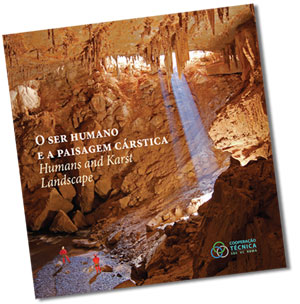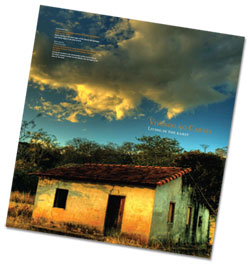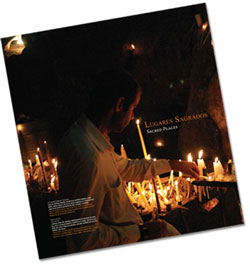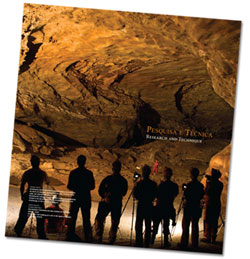
This book is the fruit of the innovative partnership for Technical Cooperation between the Brazilian Spelelogical Society, Votorantin Cements, and the Biosphere Reserve of the Atlantic Coastal Rain Forest. This partnership involves research into the speleological heritage and its protection, as well as the determination of good practices for mining and Environmental education.
The landscapes represented here portray a little-known environment, both fragile and fascinating. The cover photo was the winner of the photographic contest “Caves of Brazil”, conducted in 2011; the other photos were ~ the archives of various photographers who love karst and the underground world of Brazil.

Registers of the Past
In certain karst areas, we find the first evidence of the evolution of life on our planet: the stromatolites. The first of these structures were produced by bacteria some 4 billion years ago during the formation of limestone rock in the sea.

Living in karst regions
Life may have been difficult thousands of years ago,but in many karst areas the difficulties continue up to the present. The karst landscape incorporates a variety of peculiarities, including a shortage of surface water. Such a situation indubitably limits the possibilities of the inhabitants, forcing them to deal with a problem which is less intense in other parts of the country.

Sacred places
Our relationship with the environment has also motivated a certain spirituality. Initially, caves did not evoke the negative feelings often associated with them today.

Research and techniques
Karst and caves are also spaces for academic study. This has been motivated by a variety of factors, but the result has been the valuing of the environment by and for science in its wider sense: that of knowing and experiencing.

Enchantment
Although karst landscapes and the caves are distant worlds for most people, isolated from all except a few privileged individuals, they are really quite close to all of us. In many locations in Brazil it is possible to see lovely karst landscapes.
Technical data
Original Idea: Agreement for Technical Cooperation between the Brazilian Speleological Society (SBE), Votorantim Cements (VC), and the Biosphere Reserve of the Atlantic Coastal Rain Forest (RBMA)
Organization and authors
Heros Augusto Santos Lobo & Luiz Eduardo Panisset Travassos
Editing
Brazilian Speleological Society (SBE)
Collaborators
Alexandre Lino Pontalti, Ana Maria Lopez Espinha, Clayton Ferreira Lino, Lucas Andreata Franchin Salvo Ribeiro, Hosé Antônio Basso Scaleante, Marcelo Augusto Rasteiro, Marcos Silverio, Patrícia Monteiro Montenegro, Regiane Velozo Dias
Translation
Linda Gentry El-Dash
Proofreading
Rejane Aparecida de Castro Santos Rossi
Oscarlina Aparecida Furquim Scaleante
Cover photo
“And God said: Let there be light” Winning photo of the photographic contest: “Caves of Brazil” in 2011.
Photos of the book
Alexandre Lobo, Alexandre Felizardo, Alexandre L. Pontalti, Alexandre L. Camargo (Iscoti), Ataliba Coelho, Clayton F. Lino, Daniel De Granville, Danie de Stefano Menin, Delci K. Ishida, Francisco S. Buchmann, Gabriela de Britto Slavec, Guy Collet (in memorian), Hélio Shimada, Heros A. S. Lobo, José Frederico C. Duarte, José Roberto Ceccolini, Leda Zogbi, Luciana Alt, Luiz Afonso V. Figueiredo, Luiz Eduardo Panisset Travassos, Marcelo André, Marcos L. F. Lourenção, Marcos Silverio, Rafael R. Camargo, Renê de Souza, Ricardo de S. Martinelli, Rodrigo Motta, Rose Lane Guimarães, Silmara Zago, Vitor Moura, Vivian F. Scaggiante, Willian Marques, Willian Sallun Filho.
Illustrations (page 22)
Renato Lopes
Logo of the technical cooperation
Marcos Silverio
Graphics
S.M&A design – Samuel Ribeiro Jr
ISBN
978-85-64130-02-9

